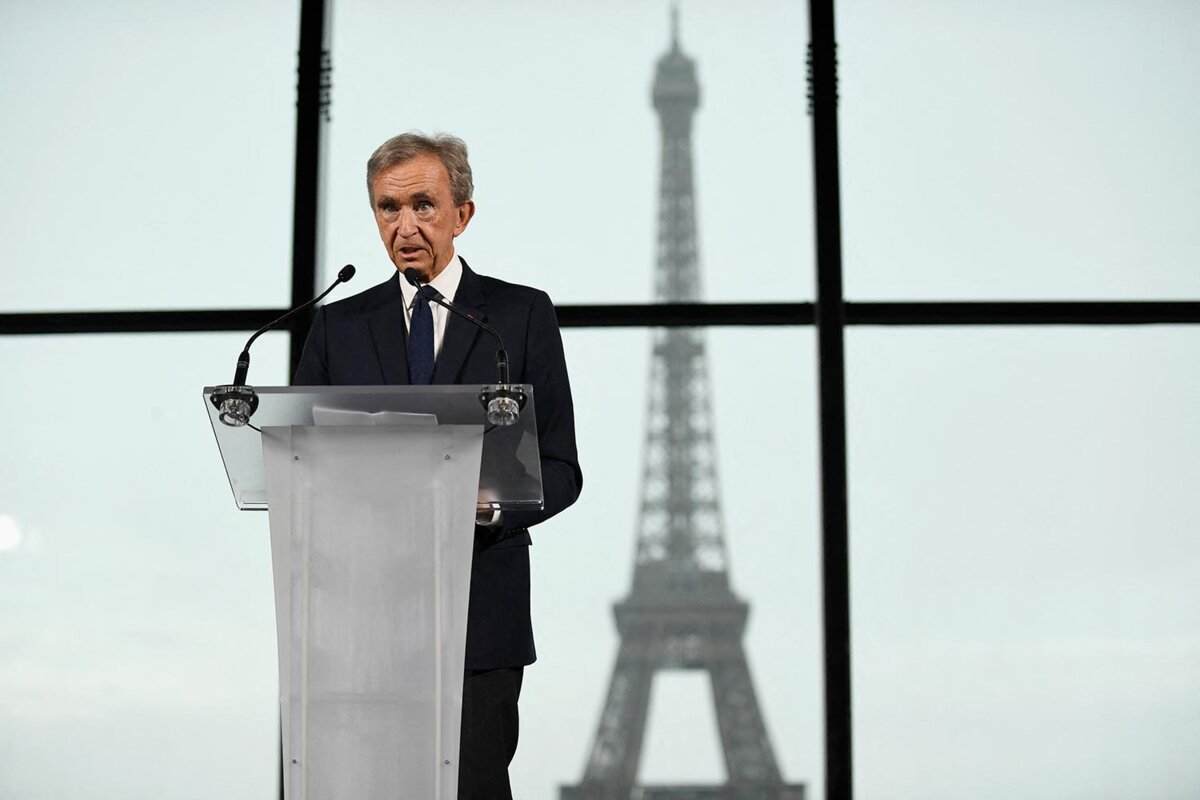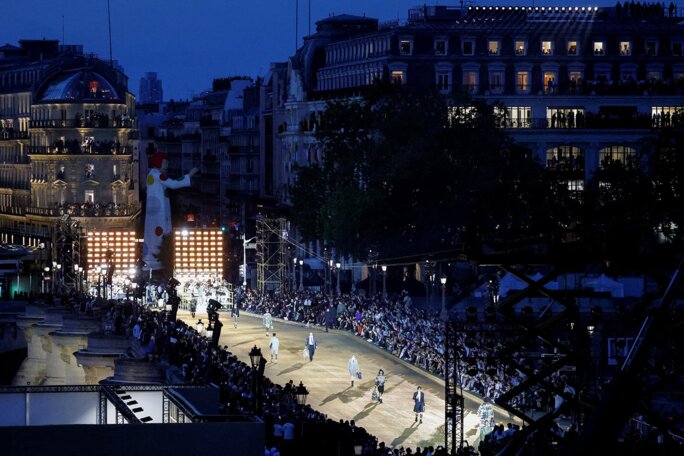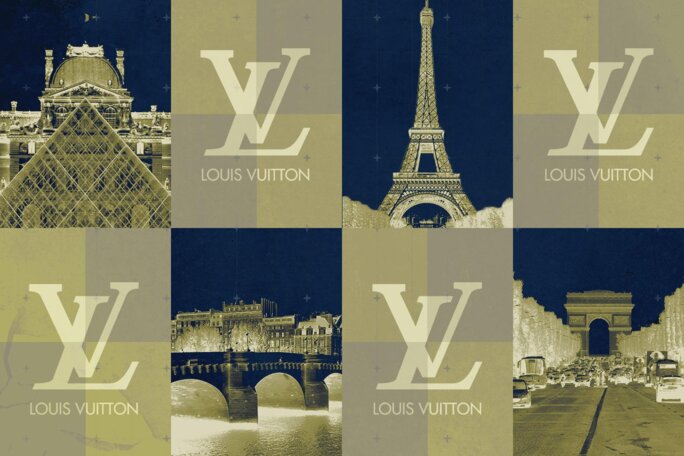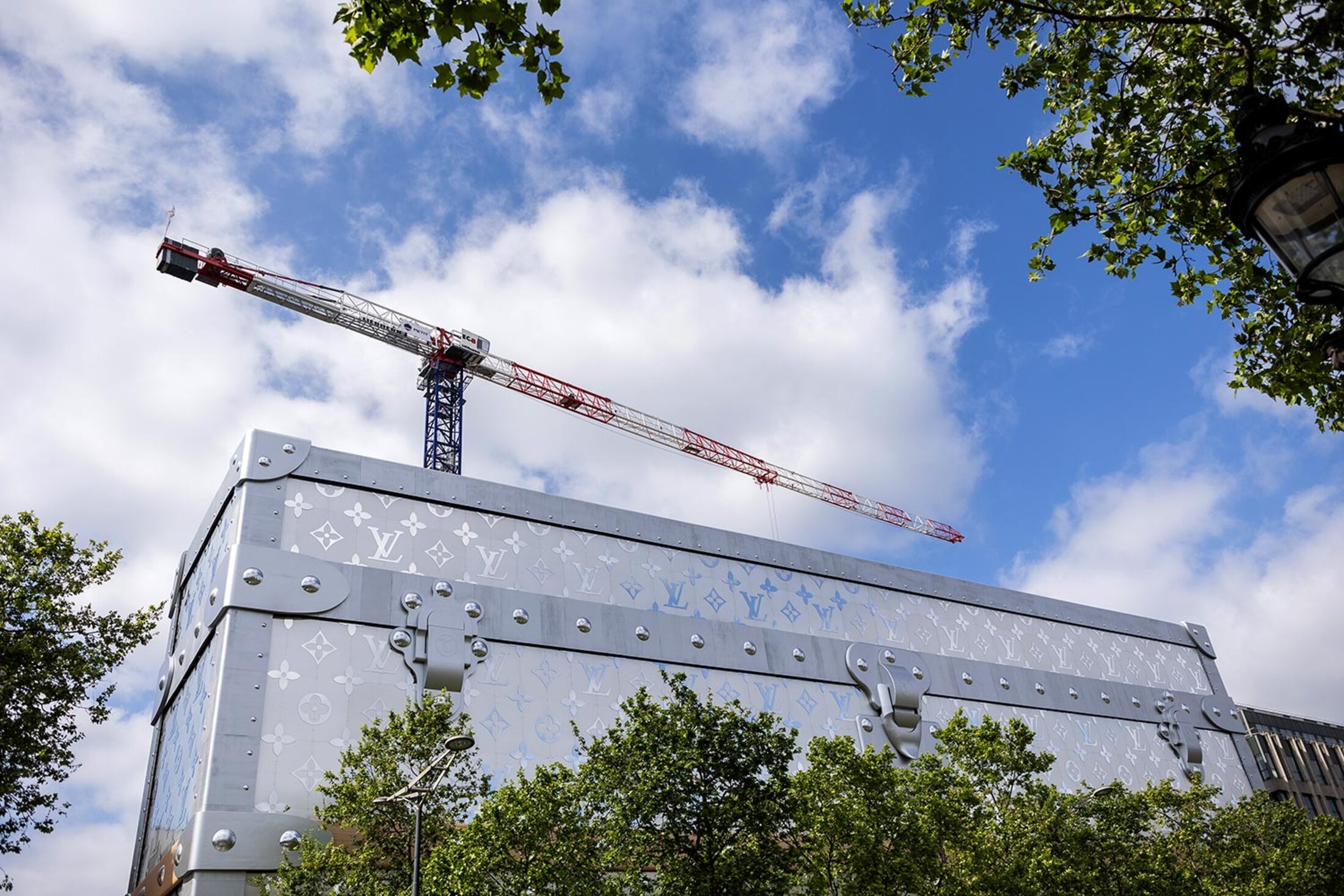One would not have instinctively thought of casting Bernard Arnault in the role of Eugène de Rastignac. Yet the communications strategy of the LVMH luxury goods group during the run-up to the Olympic Games this summer has summoned up the image of that small-town provincial who made it to Paris, as so memorably evoked by novelist Honoré de Balzac.
“Paris, here we come!” exclaimed the world's number one in luxury goods in one of its recent videos featuring the athletes it is sponsoring for the global event. The reference to the last page of Balzac's novel 'Père Goriot', in which the ambitious Rastignac lays down a challenge to the French capital, is clear.
Like that ambitious young 19th century character, the luxury goods magnate - the world's richest man according to the American magazine Forbes - has a goal: to “suck the honey” out of Paris, to use Balzac’s words. To capture its symbols, so they can serve his glory.

Enlargement : Illustration 1

That ambition has got clearer with each successive stage of the communications strategy concerning LVMH's involvement in the Paris Olympics. On July 24th 2023, the Eiffel Tower provided the backdrop as the group's chair and CEO Bernard Arnault announced that it would indeed be the sixth ‘premium’ partner for the Games, in return for the sum of 150 million euros. This is of course a drop in the ocean compared to the 10 billion euros the group spent on advertising in 2023.
Since then, LVMH’s videos on the Olympics have included the Eiffel Tower again, the Arc de Triomphe, bridges over the Seine, and the Vendôme Column – the very one to which Rastignac’s eye is drawn “almost eagerly” as he utters his famous line. “A good many LVMH Maisons originated in Paris, and Paris has always been intimately linked to the history and success of the Group, which in turn is deeply attached to the city,” says LVMH by way of justification.
The Paris Olympic Games this summer present an opportunity for the luxury magnate to complete his symbolic takeover of the capital, one that has been made all the more effective by how relatively discreet it has been. Who realises that among the prestigious brands dominating Paris's public spaces and appropriating its symbols, so many are owned by Bernard Arnault?
The businessman reigns over seventy-five ‘maisons’ or businesses: including Louis Vuitton, Christian Dior, Tiffany & Co., Krug or Veuve Clicquot champagnes, TAG Heuer and Hublot watches, Givenchy, Kenzo, Guerlain and Sephora, plus its twenty-six perfumeries scattered around the city. According to Mediapart's count of boutiques, headquarters, exhibition spaces, hotels, cafés, or group offices, there are at least 200 LVMH addresses in the capital, from the Golden Triangle of the 8th arrondissement or district to Saint-Germain-des-Prés, from the Champs-Élysées to Place Vendôme.
“Brands such as Apple or H&M open flagship stores in prestigious locations to establish their brand's reputation and upscale image. LVMH operates on another level: its policy is intrinsically linked to Paris,” says David Belliard, the green assistant mayor of Paris in charge of transforming public spaces and transport. “LVMH has a strategy to conquer the city,” he says.
Pont-Neuf fashion show went ahead despite initial city hall doubts
June 20th 2023 probably marked the turning point in terms of public awareness about this corporate quest for city conquest. On that early summer's evening, Bernard Arnault took over the 238 metres of the Pont-Neuf, the oldest bridge in Paris, which is just a stone’s throw from the Louvre and Notre-Dame.
For the very first fashion show by its new men’s artistic director, the singer Pharrell Williams, the Louis Vuitton brand rented the structure from “10 pm on June 19th 2023 to 6am on June 21st 2023,” the city of Paris says. The city authorities insist that the bridge and its surroundings were closed to traffic “for less than twenty-four hours”, though this closure nevertheless led to massive traffic jams.
Among the 1,750 VIP guests in place to applaud the models were the couple Beyoncé and Jay-Z flanking Bernard Arnault, media personality Kim Kardashian, actress Zendaya, and Formula 1 driver Lewis Hamilton. Paris Mayor Anne Hidalgo was also present at the festivities.

Enlargement : Illustration 2

The images went around the world. But the event very nearly never happened: for as David Belliard explains, the city of Paris’s administrative services had refused Louis Vuitton’s request. “I didn’t really understand why we gave this permission,” says the assistant mayor. “The city’s services, which give a technical [editor's note, and advisory] opinion, had recommended against it.” Questioned about the circumstances of this approval, the Paris mayor’s office did not respond.
“It was the mayor's office that gave the final go ahead, as it has the power to do,” says Belliard, who was himself caught up in the massive traffic jam around the area. “Blocking the Pont-Neuf, and thus the heart of Paris, is a privilege. This was a double privatisation [editor's note, of the city]: there was the advertising that came from the fashion show and all the associated communication, and also a physical aspect, since only a happy few could attend.”
According to Mediapart's information, the Paris police prefecture had previously vetoed such initiatives on several occasions. Didier Lallement, the chief of police until the summer of 2022, had categorically refused to allow such a central location to be used for a private company's benefit. The group had to wait for the arrival of the new police prefect, Laurent Nuñez, for their wish to be granted. Neither the prefecture nor Didier Lallement wanted to comment. When questioned on this, as well as on numerous other aspects of its policy in relation to Paris, LVMH did not respond to any of Mediapart's questions.
What will also have pleased the luxury goods giant is that the charge for the right to occupy the bridge was a paltry sum: 184,000 euros, paid to the city as a standard licence fee for use of a public space. This rate is governed by the same rules for all types of events and is set by the municipal council. Admittedly, LVMH also paid 250,000 euros towards the cost of security to the police prefecture, but this sum is negligible given the size of the group and the importance of the event.

Enlargement : Illustration 3

“The city has a rate card that it applies, which is fine. But perhaps LVMH could, of its own volition, offer to contribute more than a small local business? That would be welcome,” ventures the right-wing councillor David Alphand, deputy vice-president of the city council opposition group run by Rachida Dati, who is currently culture minister in President Emmanuel Macron's government.
“I was imagining that it had brought in a lot of money, at least a million euros...,” laughs a former prominent figure from Anne Hidalgo’s first term as mayor when told the amount LVMH paid. For her, while the fact that “the major cosmetics and luxury groups incorporate Paris into their communication” is “positive for the city,” a question arises: “In such circumstances, who is serving whom?”
As far as city hall is concerned, there is no debate. “An event like this attracted two billion viewers [editor's note, on the internet and social media] within forty-eight hours worldwide, and contributes to Paris's prestige and influence,” enthuses a source close to socialist mayor Anne Hidalgo. What is more, they insist, this “exceptional event served as a demonstration exercise for the police prefecture, in preparation for the opening ceremony of the Games”.
A former employee at city hall is not surprised by the relaxed approach. “You get this rhetoric from the mayor a lot: that it's vital to treat major economic players well, among whom Bernard Arnault is one of the most prominent,” he says. “You always have to be conciliatory, to go further than the administrative authorities, who are seen as too rigid and disconnected from the real issues.” The omnipresence of Marc-Antoine Jamet, LVMH's secretary general, in the corridors of city hall helps to get this message across.
Giant luggage trunk and control over public space
It is in this context that one should perhaps analyse another powerful move by LVMH, one that has ended up dominating the public space on the Champs-Élysées for four years. On Paris's busiest avenue, which already hosts nine of the group's boutiques, there now stands an eight-storey high Louis Vuitton metal luggage trunk.
Unmissable at the exit of the George V metro station, occupying as it does an entire block, this giant trunk is covered in iridescent 'LV' logos and monograms that shimmer by day and are brightly lit at night. This luxurious scaffolding hides the massive construction site at numbers 103-111 on the Champs-Élysées, which will give rise to the world's largest Vuitton store in 2027.

Enlargement : Illustration 4

In the meantime, the distinctive signs of the leather goods manufacturer are on display for all to see. “This feature imposes the brand on the gaze of passers-by and tourists strolling along one of the most beautiful avenues in the world,” complains Thomas Bourgenot, from the anti-aggressive advertising association Resistance to Advertising Aggression (RAP). “It's a giant advertising campaign at minimal cost!”
The city council insists that, in the eyes of the law, it is not an advertisement. “It is a temporary tarpaulin in accordance with the chain's rights. Many owners take this opportunity when renovating their building or store,” says city hall, rather glossing over the fact that this “tarpaulin” is a very solid metal structure which has been up for a very long time.
The authorities also point out that “since the building is listed as an historic monument, the Ministry of Culture has given its approval”, and that in accordance with the local tax on outdoor advertising, LVMH has paid out 1.7 million euros. However, green councillor Émile Meunier, who is convinced that this is a “hijacking of the local advertising regulations”, promises to take the issue to the administrative courts.
The green councillor’s suspicion is fuelled by a previous incident. From March to July 2023, LVMH installed a 15-metre high statue on the small square at the end of the Pont-Neuf on the river's right bank. The statue depicted the Japanese painter Yayoi Kusama, famous for the colourful polka dots that cover her works, and with whom Louis Vuitton has begun a long-term partnership.
Bernard Arnault's strategy can be summed up quite simply: “Paris is luxury, and luxury is me.”
This little square in the 1st arrondissement was not chosen at random. It connects three buildings that are emblematic for the group: the Louis Vuitton headquarters (housed in the historic Parisian store La Belle Jardinière), La Samaritaine, the department store LVMH has made its flagship since its reopening three years ago, and the Paris outlet of Cova, the ultra chic Milanese tea room owned by LVMH.
The luxury brand group duly requested permission from the city to install the artwork via a temporary occupation permit (an 'AOT' in French). However, it omitted to state that the statue would be holding a Vuitton bag, adorned with the brand’s famous - and gigantic - silver logo.
Only after three months, and following public protests from Émile Meunier, did the city finally react. “When we were informed of the presence of a logo, we contacted LVMH to request its removal, as it did not comply with local advertising regulations. The group acknowledged its mistake,” confirmed the city council. Nonetheless, they allowed the statue to remain for an additional month.
Hors toute considération esthétique, cette réalisation pose problème:
— Emile Meunier (@emilemeunier) May 16, 2023
- @LVMH utilise l’art pour faire son marketing sur l’espace public (artwashing)
- contraire au règlement local de publicité P1.3.5 : "la publicité par l’installation d’objet sur l’espace public est interdite." pic.twitter.com/y25KVG3hrB
“As a councillor, I'm shocked that LVMH ends up thinking it's a blessing for Paris, and not the other way around,” complains Émile Meunier. “And it annoys me that the city ends up thinking so too.” On the Right, councillor David Alphand prefers to talk about a desire on the part of the group to “capitalise on Paris's image”.
Françoise Fromonot, an architect and keen observer of the process of privatisation in major cities, is more forthright. “Bernard Arnault's strategy can be summed up quite simply: 'Paris is luxury, and luxury is me.'” she says. “That's the justification for a total hold over the public domain.”
It is a hold that is verging on subjugation. “Paris is known around the world as the city of elegance and fashion. LVMH feeds on this and banks on it to sell its products,” says Julien Lacaze, president of the heritage association Sites & Monuments, which has fought against several of the luxury group’s projects.
La Samaritaine, once a popular landmark for all
Indeed, Bernard Arnault openly admits to this strategy. “In China, Paris is hugely powerful and hugely attractive,” he told Le Monde newspaper last August. This was no casual comment, as sales in “Asia excluding Japan” accounted for 21% of the group's 86 billion euros in sales in 2023, resulting in a staggering overall net profit of 15.2 billion euros.
The billionaire has never hidden his desire to draw Chinese tourists en masse to his grand department store. “You'll find everything at La Samaritaine,” boasted the well-known advert from the 1960s, capturing the spirit of a store that remained popular for decades. Now, it houses 600 luxury brands, a luxury hotel, and a gourmet restaurant. Acquired by LVMH at the end of 2000, the four buildings forming the immense block along the Seine reopened in June 2021 after sixteen years and 750 million euros worth of renovation costs. Emmanuel Macron was at the opening, praising it as a “treasure” of “French heritage”.
“La Samar'”, as is it sometimes called, has been conceived as a tourist attraction for foreign visitors. It has become a showcase for unashamed luxury, encapsulating the “desirability” that Bernard Arnault sees as the cornerstone of commerce.
Symbolic of the change that occurred during the renovation of this landmark has been the fate of the building's famous terrace, which used to offer – free of charge – a breathtaking view over the rooftops and monuments of the capital. It has now become part of Le Cheval Blanc, the upscale hotel that occupies the most prestigious section of the building.
So to enjoy this exceptional view, one must now book a table (“weather permitting”) and be prepared to spend between 24 and 58 euros for a dish. The less well-off can stay inside La Samaritaine, where a live projection of the panoramic view is shown on a wall – when, that is, it is not replaced by an advert.
Around 20 fashion shows at the Louvre
LVMH's dominance even remains unchallenged just a few steps away, in the world's most famous museum. On March 7th 2017, Louis Vuitton held a fashion show inside the Louvre for the first time. This was an extraordinary privilege; previously, only Ferragamo had staged a show within its walls, back in 2013.
“Since then, only Louis Vuitton has held shows, on rare occasions, in the museum, in 2017, 2018, and 2021,” confirms the Louvre. On October 5th 2021, for the fashion house's 200th anniversary, they took over the Richelieu passage, the passageway to the museum. This is the very passage that “Louis Vuitton used when he visited Empress Eugénie to take her orders, the idea being to remind people that Vuitton is an imperial house”, explains filmmaker Loïc Prigent, an authoritative yet irreverent commentator on the fashion world.
For that anniversary show “there was a real sense of dialogue with the Louvre’s décor, and Nicolas Ghesquière [editor's note, artistic director of Louis Vuitton's women's collections] was inspired by 16th-century marquise jackets,” praises the expert, who is putting the finishing touches to a documentary about the history of Parisian fashion shows. But LVMH has made use of the museum's exterior spaces on many other occasions. Since 2007, “three Christian Dior Couture shows and fourteen Louis Vuitton shows have taken place in the Cour Carrée”, the museum notes.
And here “the set design doesn’t always showcase the Louvre for the Louvre’s sake; it can venture off into other visual fantasies,” points out Loïc Prigent. “They've used flying saucers, a fake Pompidou Centre, a huge geode...” These installations require several weeks of assembly and disassembly each time, during which the Cour Carrée is temporarily closed to the public.
While other luxury houses also have links with various Parisian sites (Yves Saint Laurent at the Eiffel Tower, Chanel at the Grand Palais), none match the symbolic power of the museum. As Loïc Prigent puts it: “The Louvre is the ultimate place of French power and influence, which is why LVMH associates itself with it.”
The museum's exclusive nature is reflected in the price. The cost is “300,000 euros excluding tax and technical fees” for each show, says the museum. Another luxury brand that wanted to shoot a commercial in the Tuileries Garden was told that such permission was only granted to the Louvre's trusted partners. Indeed, says the museum, these operations are reserved “primarily for the Louvre Museum’s patron companies, which have been engaged in large-scale activities for several years”.
This is the case with Christian Dior, which “is supporting the replanting of the Tuileries Garden to the tune of 9.3 million euros” over four years. And Louis Vuitton, which has donated “nearly 7.3 million euros to the museum for the period 2024-2026”. And indeed the LVMH group itself “which has undertaken to donate 15 million euros to enable the acquisition of [Jean Siméon] Chardin's 'Basket of Strawberries'”, a 1761 still-life painting classified as a “national treasure” (and thus allowing a 90% tax offset).
“LVMH has a strategy of appropriating historical monuments,” states Alexandre Moatti, a senior civil servant and former student at the elite Polytechnique university who has actively defended this 'grande école' against LVMH’s ambitions. “Heritage is a luxury, and monopolising this luxury has become a genuine strategy. But the group hides behind the image it portrays of itself as a patron.”
An unhistorical depiction of Versailles
Another iconic location, same strategy: in March 2021 Christian Dior showcased its creations in the Hall of Mirrors at the Palace of Versailles. This event took place exactly ten years after the making of an advert featuring actress Charlize Theron walking through the hall for a Dior perfume campaign. In 2018, LVMH made a financial contribution to Louis XIV's palace to acquire an invaluable “silver-gilt ewer”.
In 2013 Christian Dior also began a series of donations totalling 5.5 million euros to restore the “Queen’s hamlet”, the artificial village designed for Marie-Antoinette in the palace grounds. By coincidence or otherwise, four years later, Maison Francis Kurkdjian, LVMH’s ultra-chic perfume creation brand, secured a tie-in with the 'Perfumer’s Garden' a botanical space open to the public within the Trianon estate. The perfumer is consistently mentioned as a patron.
🌷🌹🌺🌼 @ArianeLimozin a testé le Jardin du Parfumeur !
— BFM Paris Île-de-France (@BFMParis) June 9, 2023
RDV dans le parc du Château de Versailles, pour une plongée dans l’histoire du parfum à la cour des rois de France au Jardin du Parfumeur ! @CVersailles @MaisonFK pic.twitter.com/HBq7oN5yWb
The problem, however, is that there has “never been a garden associated with perfume or its creation at Versailles, it’s an invention,” laments Julien Lacaze of the Sites & Monuments association. “It’s clear that for LVMH, this association is beneficial as it confers almost royal legitimacy. But how can the palace accept this?” he asks.
The latest tool for appropriating the image of the City of Light comes in the form of LVMH’s own products. For instance, Givenchy’s perfume 'L’Interdit' bases its marketing on references to the Paris metro. The visuals and adverts are shot in Paris public transport network (RATP) stations, and the retail display areas in stores are even adorned with the famous white tiles of the metro corridors.
Dior is the brand that goes the furthest in its desire to align its image with that of Paris. It offers a 'Dior Paris Revolution' hat inspired by the cap worn by Gavroche, the tragic urchin from the Victor Hugo novel 'Les Misérables' (costing 850 euros with its veil), and a collection of clothing and accessories highlighting “the hypnotic silhouette of the Eiffel Tower” as if viewed through X-rays (980 euros for the T-shirt, 5,900 euros for the bag).
Even more explicit is the spring-summer 2023 novelty from Dior: the “Paris map motif”, which is spread across many items in its collection. Printed in black and white and resembling an aged map supposedly inspired by the work of Christian Dior himself, it “invites one to explore the places that unite Dior and the capital”. It is a literal illustration of how LVMH wraps itself in the colours of the capital.
In the summer of 2023, this Dior-stamped map of Paris conquered the world, from a trendy district in Beijing to the iconic façade of the London department store Harrods, which for a few days was covered with Parisian streets emblazoned with the luxury brand’s logo. It was a swift leap from “Paris, here we come!” to “Paris is ours”.
--------------------------------------------------------------------------
- The original French version of this article can be found here.
English version by Michael Streeter


